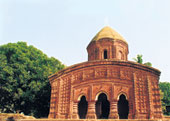 |
With its public call offices and dish antennas, Guptipara to the casual visitor might come across as yet another mofussil town rapidly losing its greenery and innocence in trying to match step with the times.
At first glance, the place does not have much to offer to the tourist apart from four Vaishnava temples. A closer look will, however, reveal a colourful past, hidden under the cloak of urban neglect and ignorance.
The temples alone could make a weekend trip to Guptipara worthwhile. They evoke awe by their grandeur and age. Arranged in a quadrangle, enclosed within a high wall, are the four shrines dedicated to Chaitanya, Brindabanchandra, Ramchandra and Krishnachandra.
According to local residents, the temples were built in different periods ? the oldest as far back as emperor Akbar?s time, to the most recent, the temple of Krishnachandra, in the reign of Nawab Ali Vardi Khan.
 |
All the structures bear characteristics of the Bengal school of architecture, with fine carvings depicting scenes from the epics and Puranas.
Guptipara was a citadel of Vaishnavite culture and learning. Even today, residents observe Ras, Dol and Rath with great enthusiasm.
Guptipara has other claims to fame, too. The community Durga puja has its roots here. The Friend of India, a monthly magazine that used to be published from Serampore, mentioned in its May 1820 issue ?a new species of Puja... called Barowaree?, which had been started at Guptipara 30 years earlier.
According to the article, a group of Brahmins formed an association to celebrate the Puja independently. The group set up a committee of 12 (baro in Bengali) to organise the event, thereby giving the Puja its name. The subscription was collected from the residents of the surrounding villages.
If you are into Bengali films, you are likely to enjoy another nugget of information. Bhola Moira, the kabiyal who engaged in musical duels with Antony in the film Antony Firingi, was born in Guptipara.
The town is also known for the delectable Gupo Sandesh. The rich and the famous of Bengal once used to head for Guptipara to savour the sweet. One distinguishing feature of the sandesh is that it is made only from cow milk.
While those interested in history would love to visit the temples of Guptipara, nature-lovers will not be disappointed either. The soothing greens, the large ponds and the twitter of birds make for a very relaxing break.
Going
It takes around two-and-a-half-hours to reach Guptipara by road or rail. Kalna-bound trains from Howrah stop at this town. You can also drive down
Travel tips
A day trip is enough to cover the sights of Guptipara. Carry packed food











